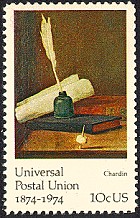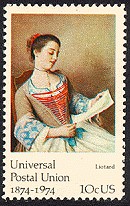
 |
The UPU and You
By Les WinickIllustrations by Dick Sine
 Today, you can address a letter to any country in the world, affix a postage stamp, drop it in your corner mail box and know that the postal administration will deliver it. Years ago, international correspondence was complicated, slow and expensive.
Today, you can address a letter to any country in the world, affix a postage stamp, drop it in your corner mail box and know that the postal administration will deliver it. Years ago, international correspondence was complicated, slow and expensive.
This is the story of one letter mailed in January 1870 from New York City to France, and the tremendous bookkeeping headaches for three nations.
Then, the nations divided the cost of mailing a letter overseas into four general categories, each demanding a fee for postage. First, the domestic postage rate of the country of origin was calculated, the United States. Then the sea postage paid the ship carrying the letter overseas. Each country through which the piece of mail traveled assessed a transit rate. Finally, the domestic rate of the country of destination, France, was added to the grand total.
In 1870, the domestic rate for a letter weighing one half-ounce or less was two cents. A postal office clerk would look up the charts in "The United States Mail and Post Office Assistant" for the exact rate for overseas mail. This was a private journal sold on a subscription basis for $1, per year, and mailed to post offices throughout the United States. The $1 fee included periodic updates on rates. The journal contained the latest postage rates for letters and newspapers mailed from the U. S. to the entire world.
Charts in 1870 told the postal clerk that the sea postage fee was an additional two cents. The clerk then looked up the date of departure of various ships bound for Europe that were authorized to carry mail. The clerk wrote the name of the ship on the front of the letter. They then held the mail in the New York City post office building until the ship was ready to sail.
Your letter is now on its way to Europe. The journey could take from four to eight months and the postage paid by the sender was only a small portion of the total postage cost.
The sea postage fee of two cents carried the letter to the closest British frontier. Britain would then forward the letter to France under their postal treaty. France, in turn, would collect postage due from the addressee at the rate of approximately 10 cents for each one-quarter ounce.
 Eventually, France would credit Britain part of the fee for forwarding the letter. The U. S. would credit the owner of the ship two cents for the sea postage fee. If the rulers of the country were angry with each other for any reason, mail would not be forwarded. It was up to the individual country to settle its own accounts with every country in the world with which it had a treaty. Each country constantly changed its rates, based on the whims of the ruler.
Eventually, France would credit Britain part of the fee for forwarding the letter. The U. S. would credit the owner of the ship two cents for the sea postage fee. If the rulers of the country were angry with each other for any reason, mail would not be forwarded. It was up to the individual country to settle its own accounts with every country in the world with which it had a treaty. Each country constantly changed its rates, based on the whims of the ruler.
The example cited was a simple mailing problem. For countries like Turkey or China, there were as many as six alternate methods of mailing a letter, each with its own system of rates. Reform was needed in the world's postal system. The U. S. had individual postal treaties with many countries during this period, each with a different payment schedule.
Postal history collectors examine the various markings on each cover to see if the proper rate was paid, if any postage due fees were collected, the name of the ship that carried the letter, and sending and receiving marks. Using this information, the collector can estimate the weight of the letter and whether the correct postage rate was applied. The ship departure and arrival dates would be a guide how long the letter was at sea and whether it was delivered promptly once it reached port. Postage Due markings can tell a collector whether the money due was in francs or pence and whether the various postal clerks en route applied the correct rate.
It was an American who took the first practical step toward the implementation of an international postal agreement. In 1862, Montgomery Blair, Postmaster General of the United States, suggested that a conference be held to discuss ways to bring about an improvement in the international postal rate structure.
 A meeting took place in Paris on May 11, 1863 and the 15 postal administrations who attended drew up 31 articles as a basis for a future conference. After several delays caused by wars and other non postal matters, the delegates met on July 1, 1874 and four main principles, which are still valid today:
A meeting took place in Paris on May 11, 1863 and the 15 postal administrations who attended drew up 31 articles as a basis for a future conference. After several delays caused by wars and other non postal matters, the delegates met on July 1, 1874 and four main principles, which are still valid today:
- A common treaty should regulate the postal service of the world.
- The right of transit by sea or land should be guaranteed by every country to every other country.
- The country of origin should be responsible for the transmission of mail and fixed rates should pay for all the intermediate services according to periodic statistics.
- Each country should keep all its postage collections on both paid and unpaid letters.
The Universal Postal Union (UPU) has continued to meet periodically to discuss international postage rates and related matters. In past years, a universal postage stamp for international mail was discussed. This would be a stamp of a common design, with a fixed postage rate, and valid for a letter addressed anywhere in the world. The idea was rejected due to currency fluctuations of individual countries. However, the idea keeps popping up at various meetings.
 Another proposal approved was a regulation naming uniform colors for postage stamps. The stamp for the international postcard rate is red, dark blue for the international letter rate and green for the international printed matter rate.
Another proposal approved was a regulation naming uniform colors for postage stamps. The stamp for the international postcard rate is red, dark blue for the international letter rate and green for the international printed matter rate.
These colors were selected because many of the countries belonging to the UPU already used these shades in their international mail and few changes would be required. America changed colors to fit this plan in 1898. Today, the color agreement is liberally interpreted so that if there is some red in an international postcard stamp, then the stamp meets UPU definitions.
Despite many letters to the editor of philatelic newspapers, these requirements have absolutely nothing to do with the color of postage stamps that a country uses internally. The UPU has never tried to regulate what domestic rate colors should be.
Les Winick